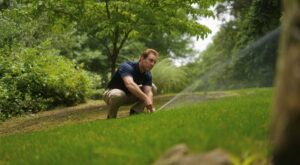More Lawn Care Advice
Irrigation: Sun vs Shade
About Irrigation: Sun vs Shade
Sun vs Shade with irrigation
Designing an irrigation system that treats sunny areas differently from shady areas is crucial for maintaining optimal plant health, conserving water, and promoting sustainable landscape practices. In this approach, the unique needs of each area are carefully considered to ensure efficient water distribution and minimize water waste. Here’s why this tailored approach is essential:
- Differential Water Requirements: Sunny areas receive more direct sunlight, leading to increased evaporation and transpiration rates, which can result in higher water requirements for plants compared to shady areas. By treating sunny areas separately, irrigation systems can deliver adequate water to meet the specific needs of sun-loving plants, promoting healthy growth and minimizing stress. Conversely, shady areas typically have lower evaporation rates and may require less frequent watering to prevent overwatering and waterlogged soil conditions.
- Soil Moisture Variability: The amount of sunlight a location receives can also impact soil moisture levels. Sunny areas tend to dry out more quickly due to increased heat and evaporation, while shady areas retain moisture for longer periods. Designing irrigation zones that account for these differences allows for precise control over water delivery, ensuring that each area receives the appropriate amount of moisture to maintain optimal soil conditions for plant growth.
- Plant Sensitivity to Sun Exposure: Plants have varying degrees of sensitivity to sunlight, with some species thriving in full sun while others prefer shade. By tailoring irrigation schedules to accommodate the sun preferences of different plant species, landscapers can create microclimates that support diverse plantings and enhance overall landscape aesthetics. This approach promotes biodiversity and resilience, as plants are better equipped to withstand environmental stressors when their specific needs are met.
- Water Conservation: Treating sunny and shady areas differently can contribute to water conservation efforts by minimizing overwatering and reducing water runoff. By optimizing irrigation schedules based on sunlight exposure, water usage can be optimized, and excess water waste can be minimized. This not only conserves water resources but also reduces water bills and supports sustainable landscape management practices.
In conclusion, designing an irrigation system that treats sunny areas differently from shady areas is essential for promoting plant health, conserving water, and supporting sustainable landscape practices. By considering the unique requirements of each area and tailoring irrigation strategies accordingly, landscapers can create thriving landscapes that are both beautiful and environmentally responsible.

